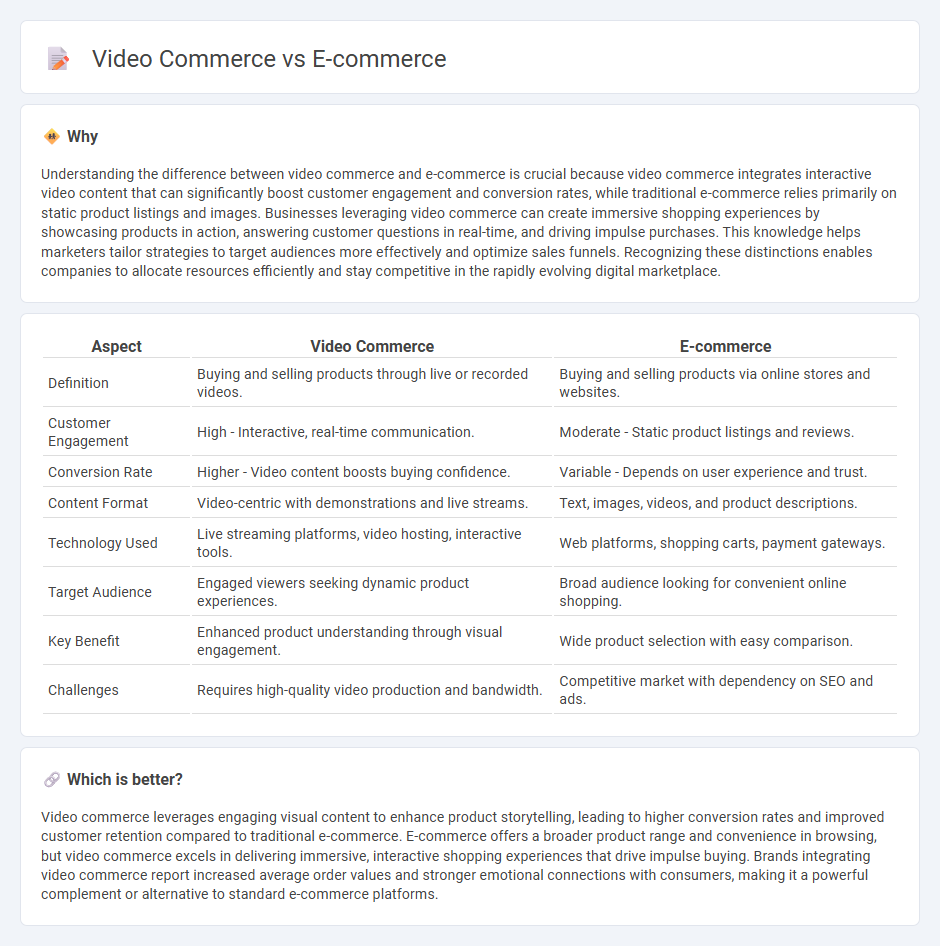
Video commerce integrates video content with shopping, enhancing customer engagement through live demonstrations and real-time interactions. E-commerce encompasses online retail platforms where products are bought and sold via websites or apps, focusing on convenience and broad accessibility. Explore how combining video commerce with e-commerce transforms digital shopping experiences and drives sales growth.
Why it is important
Understanding the difference between video commerce and e-commerce is crucial because video commerce integrates interactive video content that can significantly boost customer engagement and conversion rates, while traditional e-commerce relies primarily on static product listings and images. Businesses leveraging video commerce can create immersive shopping experiences by showcasing products in action, answering customer questions in real-time, and driving impulse purchases. This knowledge helps marketers tailor strategies to target audiences more effectively and optimize sales funnels. Recognizing these distinctions enables companies to allocate resources efficiently and stay competitive in the rapidly evolving digital marketplace.
Comparison Table
| Aspect | Video Commerce | E-commerce |
|---|---|---|
| Definition | Buying and selling products through live or recorded videos. | Buying and selling products via online stores and websites. |
| Customer Engagement | High - Interactive, real-time communication. | Moderate - Static product listings and reviews. |
| Conversion Rate | Higher - Video content boosts buying confidence. | Variable - Depends on user experience and trust. |
| Content Format | Video-centric with demonstrations and live streams. | Text, images, videos, and product descriptions. |
| Technology Used | Live streaming platforms, video hosting, interactive tools. | Web platforms, shopping carts, payment gateways. |
| Target Audience | Engaged viewers seeking dynamic product experiences. | Broad audience looking for convenient online shopping. |
| Key Benefit | Enhanced product understanding through visual engagement. | Wide product selection with easy comparison. |
| Challenges | Requires high-quality video production and bandwidth. | Competitive market with dependency on SEO and ads. |
Which is better?
Video commerce leverages engaging visual content to enhance product storytelling, leading to higher conversion rates and improved customer retention compared to traditional e-commerce. E-commerce offers a broader product range and convenience in browsing, but video commerce excels in delivering immersive, interactive shopping experiences that drive impulse buying. Brands integrating video commerce report increased average order values and stronger emotional connections with consumers, making it a powerful complement or alternative to standard e-commerce platforms.
Connection
Video commerce enhances e-commerce by integrating dynamic visual content that boosts customer engagement and conversion rates. Interactive videos allow consumers to explore products in real-time, facilitating informed purchasing decisions and streamlined checkout processes. This fusion leverages multimedia appeal and digital sales platforms to drive higher revenue and improve user experience.
Key Terms
Online Transactions
E-commerce involves online transactions primarily through websites and apps where customers browse catalogs, add items to carts, and complete purchases via secure payment gateways. Video commerce enhances this experience by integrating live or recorded video content to showcase products, driving higher engagement and increasing conversion rates through real-time interaction and demonstrations. Explore how video commerce is transforming traditional e-commerce by boosting sales and customer satisfaction.
Interactive Shopping
Video commerce leverages real-time interaction, allowing customers to engage directly with products through live demonstrations and immediate feedback, enhancing the overall shopping experience compared to traditional e-commerce platforms. Interactive shopping in video commerce incorporates features such as clickable links, live chat, and personalized product recommendations, driving higher conversion rates and customer satisfaction. Explore how integrating interactive video technology can transform your retail strategy and boost sales.
Customer Engagement
Video commerce enhances customer engagement by combining product visuals with interactive elements, leading to higher conversion rates and longer browsing sessions compared to traditional e-commerce platforms. Integrating live video streams, shoppable videos, and personalized video content creates an immersive shopping experience that fosters trust and emotional connection. Explore how video commerce can revolutionize your customer engagement strategy and drive sales growth.
Source and External Links
What Is Ecommerce? Guide To Selling Online (2025) - Ecommerce is the buying and selling of goods and services over the internet, involving transactions between businesses, consumers, or individuals, including types like B2C, B2B, and C2C, and covering activities such as online retail, subscriptions, and digital downloads.
Glossary:E-commerce - Statistics Explained - Eurostat - E-commerce is defined as the sale or purchase of goods or services via electronic transactions over the internet or other online networks, including ordering goods, financial investments, and booking accommodations, but excluding manually typed emails.
E-commerce - Wikipedia - E-commerce involves electronic buying and selling processes typically over the web with categories including B2B, B2C, C2C, and consumer-to-government, encompassing online retailing, electronic marketplaces, auctions, and marketing through various digital means.
 dowidth.com
dowidth.com